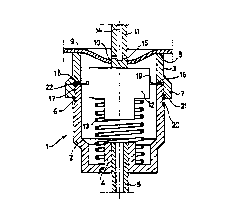Une partie des informations de ce site Web a été fournie par des sources externes. Le gouvernement du Canada n'assume aucune responsabilité concernant la précision, l'actualité ou la fiabilité des informations fournies par les sources externes. Les utilisateurs qui désirent employer cette information devraient consulter directement la source des informations. Le contenu fourni par les sources externes n'est pas assujetti aux exigences sur les langues officielles, la protection des renseignements personnels et l'accessibilité.
L'apparition de différences dans le texte et l'image des Revendications et de l'Abrégé dépend du moment auquel le document est publié. Les textes des Revendications et de l'Abrégé sont affichés :
| (12) Brevet: | (11) CA 2063796 |
|---|---|
| (54) Titre français: | UNE CHAMBRE DE MELANGE DE GAZ ET DE LIQUIDE |
| (54) Titre anglais: | A MIXING CHAMBER FOR MIXING A GASEOUS AND A LIQUID COMPONENT |
| Statut: | Périmé et au-delà du délai pour l’annulation |
| (51) Classification internationale des brevets (CIB): |
|
|---|---|
| (72) Inventeurs : |
|
| (73) Titulaires : |
|
| (71) Demandeurs : |
|
| (74) Agent: | SMART & BIGGAR LP |
| (74) Co-agent: | |
| (45) Délivré: | 1996-10-22 |
| (86) Date de dépôt PCT: | 1990-07-17 |
| (87) Mise à la disponibilité du public: | 1991-01-21 |
| Requête d'examen: | 1992-05-05 |
| Licence disponible: | S.O. |
| Cédé au domaine public: | S.O. |
| (25) Langue des documents déposés: | Anglais |
| Traité de coopération en matière de brevets (PCT): | Oui |
|---|---|
| (86) Numéro de la demande PCT: | PCT/NL1990/000097 |
| (87) Numéro de publication internationale PCT: | NL1990000097 |
| (85) Entrée nationale: | 1992-01-20 |
| (30) Données de priorité de la demande: | ||||||
|---|---|---|---|---|---|---|
|
A mixing chamber for mixing a gaseous and a liquid component, said mixing chamber being provided with separate inlet
connections for the pressurized components for the mixture which is to be formed, and an outlet connection for the formed mix-
ture to a space which is at a lower pressure. According to the invention at least one of the inlet connections consists of narrow
channels in a wall of the mixing chamber with a transverse dimension not greater than about 1 mm, and preferably less than
about 0.25 mm. In particular the mixing chamber comprises two parts having connecting surfaces which meet at the inner wall, at
least one of these surfaces being provided with grooves which, together with the other said surface, delimit the narrow channels
and more specifically one part of the mixing chamber is cup-shaped and is provided with a connection for one component, wher-
eas the other part is a cap which mates with the opening of said cup-shaped part and is provided with a shoulder, the grooves be-
ing formed in either this shoulder or in the end face of the cup-shaped part which enters into contact therewith, said grooves be-
ing connected externally with an inlet for the other component. The invention relates also to a method for forming narrow
channels in a body or object and to a body or object thus manufactured.
Note : Les revendications sont présentées dans la langue officielle dans laquelle elles ont été soumises.
Note : Les descriptions sont présentées dans la langue officielle dans laquelle elles ont été soumises.

2024-08-01 : Dans le cadre de la transition vers les Brevets de nouvelle génération (BNG), la base de données sur les brevets canadiens (BDBC) contient désormais un Historique d'événement plus détaillé, qui reproduit le Journal des événements de notre nouvelle solution interne.
Veuillez noter que les événements débutant par « Inactive : » se réfèrent à des événements qui ne sont plus utilisés dans notre nouvelle solution interne.
Pour une meilleure compréhension de l'état de la demande ou brevet qui figure sur cette page, la rubrique Mise en garde , et les descriptions de Brevet , Historique d'événement , Taxes périodiques et Historique des paiements devraient être consultées.
| Description | Date |
|---|---|
| Inactive : Renversement de l'état périmé | 2012-12-02 |
| Le délai pour l'annulation est expiré | 2010-07-17 |
| Lettre envoyée | 2009-07-17 |
| Exigences de prorogation de délai pour compléter le paiement de la taxe applicable aux petites entités - jugée conforme | 2007-07-06 |
| Inactive : CIB de MCD | 2006-03-11 |
| Accordé par délivrance | 1996-10-22 |
| Exigences pour une requête d'examen - jugée conforme | 1992-05-05 |
| Toutes les exigences pour l'examen - jugée conforme | 1992-05-05 |
| Demande publiée (accessible au public) | 1991-01-21 |
Il n'y a pas d'historique d'abandonnement
| Type de taxes | Anniversaire | Échéance | Date payée |
|---|---|---|---|
| TM (brevet, 7e anniv.) - petite | 1997-07-17 | 1997-07-03 | |
| TM (brevet, 8e anniv.) - petite | 1998-07-17 | 1998-07-15 | |
| TM (brevet, 9e anniv.) - petite | 1999-07-19 | 1999-07-12 | |
| TM (brevet, 10e anniv.) - petite | 2000-07-17 | 2000-07-10 | |
| TM (brevet, 11e anniv.) - petite | 2001-07-17 | 2001-07-05 | |
| TM (brevet, 12e anniv.) - petite | 2002-07-17 | 2002-07-04 | |
| TM (brevet, 13e anniv.) - petite | 2003-07-17 | 2003-06-25 | |
| TM (brevet, 14e anniv.) - petite | 2004-07-19 | 2004-06-01 | |
| TM (brevet, 15e anniv.) - petite | 2005-07-18 | 2005-07-07 | |
| TM (brevet, 16e anniv.) - petite | 2006-07-17 | 2006-05-09 | |
| TM (brevet, 17e anniv.) - générale | 2007-07-17 | 2007-06-18 | |
| TM (brevet, 18e anniv.) - générale | 2008-07-17 | 2008-06-25 |
Les titulaires actuels et antérieures au dossier sont affichés en ordre alphabétique.
| Titulaires actuels au dossier |
|---|
| AIRSPRAY INTERNATIONAL B.V. |
| Titulaires antérieures au dossier |
|---|
| EDGAR IVO MARIA VAN DER HEIJDEN |